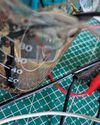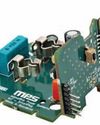5G CONNECTIVITY For Motorsports
Electronics For You
|January 2023
The article explores the feasibility and design considerations for providing 5G connectivity for motorsports

There has been interest in the motorsports industry to provide 5G connectivity for the cars on track. Typically, the cars use legacy technologies like Wi-Fi or digital video broadcast (DVB) to provide the connectivity for backhauling telemetry, video, and audio data from the cars back to the pit and media centre for broadcasting.
However, the current solutions provide a limited bandwidth, and throughput is in the range of 10 to 12Mbps. This throughput is insufficient for advanced use cases and capabilities like 4K streaming, 360-degree video, and telemetry for the racing cars.
The automotive industry is also moving towards a software defined vehicle (SDV) strategy, where the cars will need a highly reliable and low latency connectivity for frequent updates to the software, and to push gigabytes of data from the hundreds of different sensors on the cars. The move to electrification and softwarisation also needs a connectivity solution that is future-proof and ready for these requirements and remain relevant for the next decade.
Hence the option of using private 5G networks to provide connectivity for the motorsports industry cars is an attractive proposition. 5G is an option for the motorsports industry as it is designed to overcome and mitigate some of the issues involved in using wireless communications technologies for the motorsports use cases.
Proposed solution architecture
The figure on previous page shows the proposed ORAN disaggregated architecture for the motorsports use case. The solution uses the 7.2 split architecture, which is modular and extensible for the motorsports use case.
In this architecture, the distributed units (DUS) run some of the physical layer algorithms besides the radio link control (RLC) and media access control (MAC) layers. The DUS are housed in the track side units (TSU), which also provide the power for the DUS.
Denne historien er fra January 2023-utgaven av Electronics For You.
Abonner på Magzter GOLD for å få tilgang til tusenvis av kuraterte premiumhistorier og over 9000 magasiner og aviser.
Allerede abonnent? Logg på
FLERE HISTORIER FRA Electronics For You

Electronics For You
Tech Majors Are Racing TOWARDS NET-ZERO - What About You?
Apple, Microsoft, Amazon, Google, Infosys, Wipro—global and Indian firms are heading closer to achieving net-zero emissions, a mandate to combat climate change. Here is what you need to know to start your journey...
12 mins
December 2025

Electronics For You
Miniature IoT WATER TDS And LEVEL MONITOR Cum CONTROLLER
For setups that rely on stored water, clear awareness of tank level and water quality is essential.
3 mins
December 2025

Electronics For You
The Impact Of GENERATIVE AI On The Future Of AUTOMOTIVE AND EVs
Autonomous vehicles, connected ecosystems, and smart factories are only the beginning. Generative Al is pushing the auto industry beyond predictions into a bold era of creativity-from EV design to real-time diagnostics and showroom automation. Here is how GenAl is reshaping innovation across the automotive value chain.
8 mins
December 2025

Electronics For You
How AI Tools Are Making SOFTWARE DEVELOPMENT BETTER
AI is reshaping how we code, debug, and collaborate. From Copilot to automation, it is changing software development in ways worth exploring.
3 mins
December 2025
Electronics For You
How AI Tools Are Making SOFTWARE DEVELOPMENT BETTER
AI is reshaping how we code, debug, and collaborate. From Copilot to automation, it is changing software development in ways worth exploring.
3 mins
December 2025

Electronics For You
5 Interesting Reference Designs FOR SMART HOMES
Smart home devices are transforming the way people interact with their appliances. They make homes more convenient, secure, and energy-efficient. From smart plugs and energy monitors to smart locks and thermostats, reference designs help design engineers create connected products that are easy to use, consume less power, and are reliable. These designs allow you to control devices remotely, track energy use, extend battery life, and automate routines. They provide practical solutions for upgrading homes and small commercial spaces without major modifications.
3 mins
December 2025

Electronics For You
Fancy USB LED VASE
This USB LED vase is a simple yet elegant device that fuses art with electronics to create a decorative lighting display. Powered directly from a standard USB port, it uses readily available components such as MOSFETs, resistors, capacitors, and LEDs to produce a striking, dynamic sequence of lights.
3 mins
December 2025

Electronics For You
"WHAT OTHERS SELL IN FOUR BOXES WE BUILT IN ONE"
Years of custom field work are shaping a product line with its own cloud, its own hardware, and a market that is now beginning to recognise its value.
8 mins
December 2025

Electronics For You
BUILD LARGE LANGUAGE MODELS
Large language models are machine learning models designed for a range of language-related tasks such as text generation and translation. Here’s how open source software can help you build your own large language model.
6 mins
December 2025

Electronics For You
Rare Earth Or Rare Ingenuity? India Remains Between The Two
With China firmly controlling rare earth exports, India confronts a critical moment in its technological trajectory.
8 mins
December 2025
Translate
Change font size

